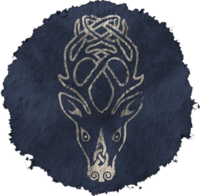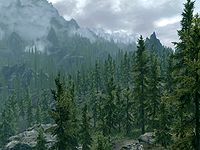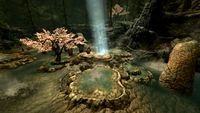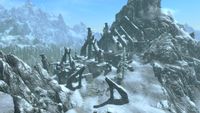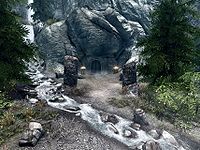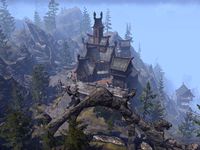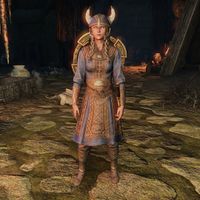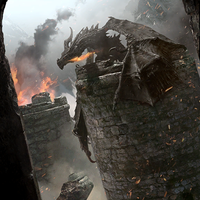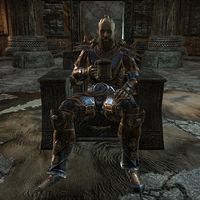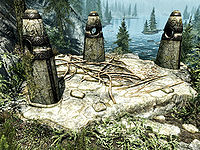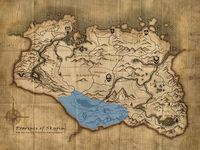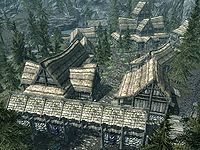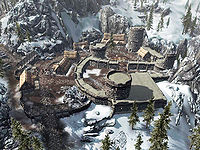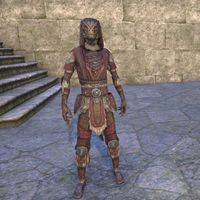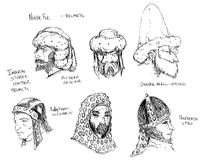Lore:Falkreath Hold
| Falkreath | |
|---|---|
| Type | Region |
| Continent | Tamriel |
| Province | Skyrim |
| Subregions | Bloodlet Peaks Brittleshin Hills Pine Forest |
| Appears in | Skyrim, ESO |
Falkreath Hold (or simply called Falkreath)[1]:573 is one of the main holds of Skyrim, known for its lush pine forest. Lake Ilinalta, the province's largest body of freshwater, constitutes a significant portion of the hold. The people of the hold are generally prosperous farmers and loggers, thanks to the Ilinalta.[1]:573 Falkreath has an ancient association with battle and death. Like the hold, the capital city is called Falkreath, but it is also known as the "heroes' graveyard". It contains one of the largest cemeteries in the province.[2][3] Falkreath's alignment has sometimes shifted between the Kingdom of Skyrim and the Colovian Estates, the autonomous government of western Cyrodiil.[4][5]
The region connects the southern holds of Skyrim with the northern reaches of west-central Tamriel, making it a major thoroughfare.[1]:573 It is historically neighbored by the Jerall Mountains to the south, the Reach to the northwest, the Rift to the east, and Whiterun Hold to the north.[6] From across the provincial border to the south, Falkreath is connected to northern Cyrodiil near County Bruma and Craglorn in northeast Hammerfell.[7][8]
Contents
Society and Ecosystem[edit]
Falkreath is predominantly inhabited by Nords of Skyrim, but many races have at one point inhabited or laid claim to the region, including Colovians, [4] the Keptu, Minotaurs,[9][10] and the Orcs.[11] Many in the capital city, from shops to families, draw inspiration from battle and death for their names. The region's signature cheese dish, Barrowost, resembles common eidar cheese but is exclusively aged in Nordic barrows. The cheese acquires an intense earthy sweetness and is punctuated with sharp notes. The Nords practice an ancient tradition with Barrowost called "grave curd" in which fresh cheese is interred atop of the coffin of the recently deceased. On every anniversary, the bereaved eat a fifth of the cheese until it is finished.[3]
Falkreath has at times been an independent state.[4] A merchant family from the late Second Era, the Far Falkreath Estate, had strong ties to the Holds of Skyrim.[12] The Glenmoril Wyrd, more specifically the Hagfeather Coven, has lived in western Falkreath since at least the mid-Second Era. The Hagfeathers were known to worship the Daedric Prince Namira,[13] but at some point, a coven in Falkreath worshipped Hircine. It was the Hircine-worshipping coven which bestowed lycanthropy on the Companions, starting with the Harbinger Terrfyg.[14][15]
The region's main feature, aptly named Pine Forest,[16] stretches between the borders of the Reach and Whiterun, as well as the snow-laden country between the Throat of the World and the Jerall Mountains. It is dense with coniferous trees and a wide variety of flora, including mora tapinella,[17] all four varieties of mountain flower, nightshade,[18] nirnroot, and thistles.[19] There are also many snowberries throughout the eastern hills and the path toward Cyrodiil.[20]
Falkreath hosts a wide variety of wildlife. The temperate water of the enormous Lake Ilinalta hosts many different types of fish. The more common include Abecean longfin, Cyrodilic spadetail, histcarp, river betty, salmon, silverside perch, and slaughterfish. Others are catfish, pearlfish, pygmy sunfish, and the spadefish.[21]
In the forest can be found several species of wolf and bear, as well as frostbite spiders and spriggans. The local Nords were able to tame sabre cats and train them as mounts.[22] A cave known as Bloated Man's Grotto protects some wildlife within an idyllic subterranean ecosystem. Several types of butterfly live in the grotto, such as blue butterflies, the monarch butterfly, and even the luna moth.[23] The pine thrush is a bird commonly found in southern Skyrim and Falkreath.[24]
In the east, a road connects Helgen to the Rift through a mountain pass called the Lion's Den.[25][26] Southeast of Falkreath's capital is one of the fabled Ancestor Glades, hidden groves across Tamriel where the Ritual of the Ancestor Moth can be performed. The ritual, used by the Moth Priests to read Elder Scrolls, involves placing a "draw knife" in the glade's central grotto to harvest the canticle tree and attract ancestor moths.[27]
History[edit]
Ancient background[edit]
Falkreath's ancient history is intertwined with the many cultures and people of the surrounding area. Though the name is of elvish origin,[1]:574 the city was founded by Bjarfrud Skjoralmor, an ancient Nord warrior who repeatedly drove a "beastly host" from their "heathen wood". As the host kept returning, he eventually decided to chop down the woods and create a town.[9] These woods had evidently been the ancestral home of a group of Minotaurs.[10] The Orcs may have lived in Falkreath Hold, as well, claiming it was their ancient right to return to the land in the early Second Era.[11] One of Falkreath's oldest ruins is the Twilight Sepulcher, an important sanctum for Nocturnal, the Daedric Prince of Darkness. Deep in its halls is the Ebonmere, a portal to Nocturnal's plane of Oblivion, Evergloam. It has existed since long before recorded history.[28]
Presumably, ancient Falkreath was home to a Nedic tribe called the men-of-'kreath, one of several which were enslaved by the Ayleids of the Cyrodilic heartland and taken to Sardavar Leed.[29] Some no doubt participated in the Alessian Slave Rebellion, which overthrew the Ayleid Empire. Those elves who tried to escape north into Skyrim during the Ayleid Diaspora were slaughtered by High King Vrage and his forces.[30]
Unlike other parts of Skyrim, the Dragon Cult has only one known temple: Bleak Falls Barrow, in the mountains west of Riverwood, close to the border with Whiterun Hold. Deep in its interior, the Keeper of the Dragonstone was buried and given the eternal mission to guard their namesake, a stone slab with a map of dragon burials all over Skyrim. When the hold was formally established is unknown, but it was sometime in early First Era, or perhaps even in the Merethic, just after the Dragon War.[31][nb 1]
Early History[edit]
In the early First Era, Falkreath Hold took part in the War of Succession, a roughly half-a-century-long war for the High Kingship after the death of Borgas. Falkreath would eventually pledge allegiance to Jarl Olaf One-Eye.[32][33] Roughly two hundred years later, Falkreath Hold come into major conflict again, this time with the Alessian Order. The First Empire had at one point acquired southern Skyrim, only to lose it to the Nords ruled by High King Kjoric the White.[1]:574 Sometime around 1E 478, eight months before Rislav Larich became King of Skingrad, the High King died at the Battle of Sungard[34] while defending Falkreath city.[1]:574 As the Moot was deciding on who should succeed him, the Empire reclaimed Falkreath Hold. The Pact of Chieftains decided on Kjoric's son, Hoag Merkiller, as the new High King. While accounts claim Hoag died in the Battle of Glenumbra Moors,[35] a legend persists that he died on the same spot his father did when he reclaimed Falkreath for the last time years later.[1]:574
By the late First Era, Falkreath and its environs were part of the Colovian Estates.[4] In 1E 2331, both the estates and their enemies, the former Alessian-controlled Cyrodiil, were destitute thanks to the War of Righteousness.[36][37] For the next four hundred years, the Colovian kings were desperate and greedy for wealth, or as the Remanada describes it, they "became through pride and habit as like thief-barons and forgot covenant".[4] In 1E 2703, the Tsaesci of distant Akavir landed on the northern shores of Skyrim and Morrowind. They cut a swathe south until they reached Falkreath's side of the Pale Pass, en route to Cyrodiil.[38][39] Reman assembled the disparate Colovians and the Nibenay to confront them at the mountain pass. The Imperials emerged victorious, and Reman went on to become the first Emperor of the Second Empire.[37]
The Kingdom of Western Skyrim[edit]
After the death of High King Logrolf in 2E 431, contenders for the High Kingship came down to Jarl Svartr of Solitude and Logrolf's daughter, Freydis. In the end, two separate kingdoms were established between the east and the west. Falkreath Hold joined High King Svartr to create the Kingdom of Western Skyrim.[40] Roughly around that time, Orsinium was destroyed by the Bretons, and many Orcish refugees flocked elsewhere. Chieftain Yashnag gro-Yazgu brought many of his people east to build a chiefdom in western Falkreath, which would become one of the largest examples of Orcish dominion to ever rise in Skyrim.[11]
Yashnag's chiefdom was a bane to the Nords of Falkreath Hold for thirty years. At some point, the chieftain killed the Jarl in battle. His son, Hakkvild, inherited the throne to a decrepit hold largely occupied by the Orcs. In 2E 467, Hakkvild challenged Yashnag and his champions in an obscure Orcish ritual trial by combat and single-handedly won each encounter. How he came to learn of this ritual is unknown, but Yashnag's followers fled Skyrim for the Wrothgarian Mountains and Bangkorai.[11][41] Hakkvild burned the chiefdom down to the ground and earned the sobriquet "Yashnag-Slayer".[11] In 2E 566, Chief Kurog gro-Bagrakh assembled a force of Orcish warriors to reclaim Yashnag's former land in Falkreath, but they were eventually pushed out by the Nords.[42]
After the fall of the Longhouse Emperors in 2E 577, Falkreath Hold was caught in a minor but destructive conflict between the Second Legion and the former advisors of the Emperors, the Icereach Coven. The legionnaires chased the witches' coven north over the Jerall Mountains and confronted them north and west of Falkreath's capital. After the slaughter of legion soldiers, the coven took shelter in the graves west of the city. The witches managed to escape them when their matriarch, Mother Ciannait, resurrected a horde of undead Nords and used illusion magic to strike fear into the soldiers. While the Second Legion retreated back to Cyrodiil, the Icereach Coven fled north to their home on the Sea of Ghosts.[43]
The Siege of Falkreath Hold[edit]
In 2E 582, citizens of Falkreath's capital were kidnapped by beasts at night. Jarl Hjurgol Skjoralmor dismissed these claims as mere rumors.[44] At that same time, Reachmen raided villages across the countryside and refugees poured into Falkreath.[45] Led by the man-bull warrior, Domihaus the Bloody-Horned, an allied clan of Reachmen and Minotaurs called the Dreadhorn would lay siege to the city for weeks.[45]
While Jarl Hjurgol Skjoralmor was held up in his keep, his daughter, Thane Eerika Skjoralmor, led the defense of the city.[46] A runner just barely made it out of the city and brought word of the assault to the Undaunted, who sent warriors to help break the siege. These warriors arrived from the eastern outskirts of town and fought their way through to Eerika and together they killed Domihaus. But before they could, Domihaus managed to breach the Jarl's keep, and in the chaos, the Jarl was killed. Consequently, Eerika inherited the throne.[46]
It is unknown if Falkreath Hold continued its association with the Kingdom of Western Skyrim. Both entities saw a drastic change in leadership in the same year, with Eerika inheriting the throne from her father and later Princess Svana taking the throne after the death of her father, High King Svargrim.[UOL 1][47]
Falkreath in the Third Empire[edit]
By the late Second Era, Falkreath was again part of the Colovian Estates. Their ruler, King Cuhlecain, wanted to unify the Estates, but in order to do so, he needed to secure his borders to the north with the Reach, where the Nords and local Reachmen had warred for centuries. In an attempt to solidify his hold, he allied with Skyrim and chose his general, Hjalti Early-Beard, to lead a small band of Colovian warriors and Nord berserkers. The Battle of Old Hroldan proved instrumental in Cuhlecain's efforts to unify the west, which came to fruition within a year.[5]
Holds such as Falkreath were kingdoms under the Third Empire,[48][49] and like the rest of Skyrim, they supported Queen Potema Septim in the War of the Red Diamond.[50] When the Oblivion Crisis broke out in 3E 433, Skyrim was under siege and faced severe casualties, specifically in the Old Holds, and it was said everything between Falkreath and Windhelm was laid to waste by the daedric hordes.[51]
Falkreath in the Skyrim Civil War[edit]
Sometime after the Pale Pass was re-discovered in 3E 433,[52] an inter-provincial road was established between Cyrodiil and Skyrim. The Pale Pass entered Skyrim through Falkreath Hold, specifically south of Helgen, and Fort Neugrad was there to guard the road between them.[53] By roughly 4E 180, the Empire had a strong military presence in the region, especially through the town of Helgen.[8]
After the death of High King Torygg in 4E 201, the province fell into the Skyrim Civil War between the Imperial Legion, based in western Skyrim, and the Stormcloaks, who rallied the Old Holds together for their common cause. Jarl Dengeir of Stuhn was a forthright Stormcloak supporter, but vacated the hold's throne and was replaced by his nephew, Siddgeir, a supporter to the Empire.[2] The Legion based in Falkreath was spearheaded by Legate Skulnar, and Fort Neugrad was a vital point of contention for control over the region.[54]
In that same year, the Imperial Legion captured Ulfric Stormcloak after a skirmish near Darkwater Crossing. The Jarl, Stormcloak soldiers, and other criminals were taken to Helgen to be publicly executed. In attendance was General Tullius, the Military Governor of Skyrim, and Elenwen, the First Emissary of the Thalmor.[55] Before the Jarl could be executed, however, a black dragon descended onto the town and razed it to the ground. In the ensuing destruction, Ulfric escaped town and fled back to Windhelm. Meanwhile, a doom-driven hero escaped through Helgen's underbelly: the Last Dragonborn, who later scaled the northern mountains to reach Bleak Falls Barrow and retrieve the Dragonstone.[55][56]
It was also around this time that the Penitus Oculatus tracked down a Dark Brotherhood sanctuary in Falkreath Hold and destroyed it. It is unknown if the Brotherhood survived the assault or died out completely in the province.[57][58]
Known Rulers[edit]
- Unknown Period
- The Second Era
- Unnamed Jarl of Falkreath[11]
- Jarl Hakkvild Yashnag-Slayer (ca. 2E 467)[11]
- Jarl Hjurgol Skjoralmor (2E ? – 2E 582)[59]
- Jarl Eerika Skjoralmor (2E 582 – 2E ?)[59]
- King Cuhlecain (ca. 2E 852)[5]
- The Third Era
- The Fourth Era
- Jarl Dengeir of Stuhn (4E ? – 4E 201)[60]
- Jarl Siddgeir (4E 201 – 4E ?)[60]
Notable Places[edit]
- Ancestor Glade
- One of the several ancestor glades of Tamriel, found high in the Jerall Mountains over Falkreath
- Bleak Falls Barrow
- A large Dragon cult temple over the mountains west of Riverwood, burial ground of the Dragonstone
- Falkreath
- The capital city of the hold, located on the main road between the region and the provincial border
- Fort Neugrad
- The regional stronghold of Falkreath, found on the main road north of the Pale Pass
- Granite Hill
- A town located somewhere in northwest Falkreath
- The Guardian Stones
- An ancient landmark next to the mouth of the White River, contains three standing stones
- Helgen
- An Imperial town on the east crossroad sometimes called the "Gateway to the North"
- Lake Ilinalta
- The largest inland body of water in Skyrim, found between Falkreath town and the Brittleshin Hills
- Twilight Sepulcher
- An ancient ruin with ties to Nocturnal and a gateway to her realm
Gallery[edit]
Notes[edit]
- While Falkreath is renowned for its pine forests, it is unknown if the obscure conflict known as the War of the Pines is connected to Falkreath.[61]
- Falkreath Hold is excluded in The Holds of Skyrim, a book giving a basic outline of Skyrim's holds.[62]
See Also[edit]
- For game-specific information, see the Skyrim and Elder Scrolls Online
 articles.
articles.
Books[edit]
- Cheeses of Skyrim: Riften, Falkreath by B. — Descriptions of the cheeses of Skyrim
References[edit]
- ^ a b c d e f g The Elder Scrolls V: Skyrim: Prima Official Game Guide — David Hodgson
- ^ a b Nenya's dialogue in Skyrim
- ^ a b Cheeses of Skyrim: Riften, Falkreath — B.
- ^ a b c d e Remanada
- ^ a b c The Arcturian Heresy — The Underking, Ysmir Kingmaker
- ^ Map of Skyrim – The Elder Scrolls V: Skyrim
- ^ Map of Tamriel – The Elder Scrolls Online
- ^ a b Falkreath Banner item description text in Blades
- ^ a b c Epitaph of Bjarfrud Skjoralmor
- ^ a b Meet the Character - Domihaus the Bloody-Horned — Gherig Bullblood
- ^ a b c d e f g Orcs of Skyrim — Thora Far-Wanderer
- ^ Tobias' biography for Redguard
- ^ The Glenmoril Wyrd — Lady Cinnabar of Taneth
- ^ Kodlak Whitemane's dialogue in Skyrim
- ^ Kodlak's Journal — Kodlak Whitemane
- ^ Astrid's dialogue in Skyrim
- ^ Mora Tapinella in Skyrim
- ^ Nightshade in Skyrim
- ^ Thistle Branch in Skyrim
- ^ Snowberries in Skyrim
- ^ Fishing Mastery, v2 — Swims-In-Deep-Water
- ^ Sabre Cat mount description text in ESO
- ^ Bloated Man's Grotto location in Skyrim
- ^ Pine Thrush Eggs in Skyrim
- ^ Into the Lion's Den
- ^ The Lion's Den location in ESO
- ^ Dexion Evicus' dialogue in Skyrim: Dawnguard
- ^ Karliah's dialogue in Skyrim
- ^ The Adabal-a — Morihaus
- ^ Ayleid Survivals in Valenwood — Cuinur of Cloudrest, 4th Tier Scholar of Tamrielic Minutiae
- ^ Farengar Secret-Fire's dialogue in Skyrim
- ^ King Olaf's Verse
- ^ Pocket Guide to the Empire, 1st Edition: Skyrim — Imperial Geographical Society, 2E 864
- ^ Rislav The Righteous — Sinjin
- ^ Five Songs of King Wulfharth
- ^ Systres History: Volume 4 — Trilam Heladren, Associate Dean of Eltheric History, University of Gwylim
- ^ a b Pocket Guide to the Empire, 1st Edition: Cyrodiil — Imperial Geographical Society, 2E 864
- ^ Legacy of the Dragonguard — Kiasa-Veda, the Chronicler of Blades
- ^ Pocket Guide to the Empire, 3rd Edition: Other Lands — Imperial Geographical Society, 3E 432
- ^ The Crown of Freydis — Taleon Mythmaker
- ^ Forsaken Stronghold loading screen text in ESO
- ^ The Chronicles of King Kurog, Book IV — Zephrine Frey, Chronicler of Wayrest
- ^ Meet the Character - Mother Ciannait — Optio Cornelia Midara
- ^ In Reply to Concerning Rumors — Jarl Hjurgol Skjoralmor
- ^ a b Unfinished Letter to Marika
- ^ a b Falkreath's Demise group quest in ESO: Horns of the Reach
- ^ Daughter of the Wolf story quest in ESO: Greymoor
- ^ Pocket Guide to the Empire, 3rd Edition: The Throat of the World: Skyrim — Imperial Geographical Society, 3E 432
- ^ a b Falcrenth location and rumors in Arena
- ^ Brief History of the Empire, v 2 — Stronach k'Thojj III
- ^ Tamriel Gate Response rumors in Oblivion
- ^ Lifting the Vale quest in Oblivion
- ^ Imperial Missive
- ^ Falkreath Imperial court in Skyrim
- ^ a b Unbound story quest in Skyrim
- ^ Bleak Falls Barrow story quest in Skyrim
- ^ Death Incarnate faction quest in Skyrim
- ^ Destroy the Dark Brotherhood! faction quest in Skyrim
- ^ a b Falkreath's Demise group quest in ESO: Horns of the Reach
- ^ a b Siddgeir's dialogue in Skyrim
- ^ Drain Vitality third word wall in Skyrim
- ^ The Holds of Skyrim
Note: The following references are considered to be unofficial sources. They are included to round off this article and may not be authoritative or conclusive.
